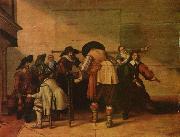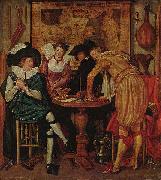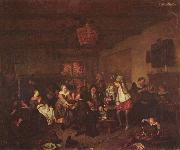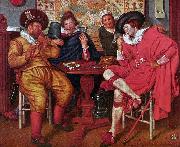
|
Jan Olis
|
|||
|
|
|||
| painted Frohliche Gesellschaft in 1644 | |||
|
|
|||
|
Frohliche Gesellschaft new25/Jan Olis-755447.jpg Painting ID:: 88974 |
1644(1644) Medium oil on oak panel Dimensions 49 x 63,5 cm cjr | ||
|
|
|||
|
Willem Pieterszoon Buytewech
|
|||
|
|
|||
| (1591/1592, Rotterdam - September 23, 1624, Rotterdam) was a Dutch painter, draughtsman and etcher of the Golden Age. He is often considered the "inventor" of Dutch genre painting. For his preference of irony, his contemporaries named him Gheestige Willem (Jolly or spiritual William). Buytewech was the son of Pieter Jacobsz, a cobbler and candlemaker. He learned his trade in Haarlem, where he became a member of the artists' guild (Haarlem Guild of St. Luke) in 1612, together with Hercules Segers and Esaias van de Velde.[1] Frans Hals, who was a member of this guild since 1610, had much influence on Buytenwech's work, as shown by the many drawings that the latter made after Hals's paintings. After his marriage on November 10, 1613 with Aeltje van Amerongen, of a patrician family, he returned to Rotterdam. There Hendrik Martenszoon Sorgh was one of his pupils. Buytewech was primarily a graphic artist, mostly of landscapes and genre pieces, but occasionally also of biblical and allegorical themes. Of his paintings only eight have survived to this date, all genre pieces, most depicting merry companies. Willem Buytewech's Merry CompanyHe died at the age of only 32 or 33 of unrecorded causes. His son Willem Willemsz Buytewech (1625-1670), born after his death, would become a painter as well. | |||
|
|
|||
|
Frohliche Gesellschaft new25/Willem Pieterszoon Buytewech-839869.jpg Painting ID:: 89457 |
c. 1615(1615) Medium oil on canvas Dimensions 72,6 x 65,4 cm cjr | ||
|
|
|||
|
Richard Brakenburgh
|
|||
|
|
|||
| (1650, Haarlem - 1702, Haarlem), was a Dutch Golden Age painter. According to Houbraken he was a light-hearted poet from Haarlem. He was the pupil of Hendrik Mommers who went on to paint clever genre scenes in the manner of Adriaen van Ostade. Though some said he was the pupil of Bernard Schendel, they were the same age and painted in similar styles. He was successful enough at his art that his Frisian widow was able to purchase an annuity after his death in Friesland. According to the RKD he is registered in Leeuwarden during the years 1670-1687.He is known for both Italianate landscapes and portraits. He painted similar subjects to those of Schendel, representing merry-makings and drunken assemblies. His pictures are ingeniously composed, and well coloured, something in the manner of Adriaan van Ostade, though greatly inferior. They are painted with facility, although they have the appearance of being very highly finished; and he perfectly understood the management of chiaroscuro. His greatest defect is his incorrect drawing of the figure, which he appears not to have studied from nature. The Vienna Gallery has two 'Peasant Scenes' by him, said to have been painted in 1690; the Berlin Museum one, and the Amsterdam Gallery one. In the Brussels Gallery is a 'Children's Feast,' signed and dated 1698; and the Rotterdam Museum has a 'Doctor's Visit,' signed and dated 1696. In Windsor Castle are two good 'Artists' Studios ' by him. He also sometimes practised the art of engraving. He was the teacher of Wigerus Vitringa, Abraham Pardanus, and Gillis de Winter. He was followed by Jan Steen and Bernardus van Schijndel. He died at Haarlem in December 1702 and was buried in January 1703. | |||
|
|
|||
|
Frohliche Gesellschaft new25/Richard Brakenburgh-745447.jpg Painting ID:: 89737 |
second half of 17th century Medium oil on canvas Dimensions 76 x 91 cm cjr | ||
|
|
|||
|
Willem Pietersz. Buytewech
|
|||
|
|
|||
| Willem Pieterszoon Buytewech (1591/1592 - September 23, 1624) was a Dutch painter, draughtsman and etcher of the Golden Age. He is often considered the "inventor" of Dutch genre painting. For his preference of irony, his contemporaries named him eGheestige Willeme (Jolly or spiritual William). | |||
|
|
|||
|
Frohliche Gesellschaft new25/Willem Pietersz. Buytewech-763397.jpg Painting ID:: 92622 |
Medium color on canvas mounted on wood Dimensions 52 X 62 cm TTD | ||
|
|
|||
|
Also Buy::. For Following Paintings / Artists / Products, Please Use Our Search Online: |











